Ask Mike Schaefer, incoming chairman of the Engine Rebuilders Association (AERA) what the association means to him and he’ll have an immediate and impactful answer: "Without AERA, we wouldn’t have survived."
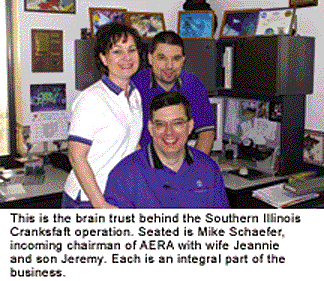
When he opened the doors to Southern Illinois Crankshaft, Red Bud, IL, in November of 1985, and bought his first crank grinder, the salesman also brought him an association application. The very next AERA convention was in St. Louis, just a few miles down the road from Red Bud, giving him the opportunity to attend. He has missed very few since.
During the early years of the business, the AERA Tech Line and PROSIS software system were instrumental in Southern Illinois Crankshaft’s continued growth, says Schaefer. "When we became members and started to use tech service, we found out how much it did for our business. When we had a question about anything, we could get it answered. AERA had the answers for us. In our early years, when we didn’t know anything, that was really an asset to us. Basically, my progression on the association board and through the chairs has just been a bit of giving back what I have taken. I’ve taken a lot from AERA, and I thought it was time to give some back."
Schaefer grew up on a farm and had been around machinery his entire life. He had also worked in a tool and die shop for a short time, but was driving truck when he decided to open his business. "I have family in the salvage business," explains Jeannie, Mike’s wife and partner. A lot of machine shops were closing down in our area, and they had nobody who could do machine work for them. Mike’s experience in a machine shop helped us decide to go after this opportunity."
With just two customers and after nearly a year of planning the Schaefer’s opened the doors in a rented 1,600 sq.ft. building, starting with that one crank grinder. The business saw steady growth as they added equipment and services, until in 1993 they built their own 7,600 sq.ft. facility.
"A key to our success is the involvement of my family," Schaefer says. "My wife is in charge of all the financial matters relating to the business. I don’t think many shops pay enough attention to maintaining profitability. Jeannie keeps a tight hold on time and labor management so that we are charging what we need to be to remain profitable. I must make a profit to continue to be here when my customers need me. Jeannie makes sure that we are always on top of our costs – making sure we are charging what we need to charge."
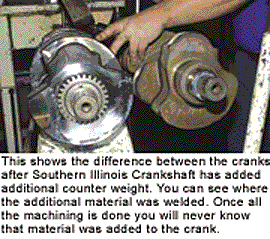
Both Schaefers believe that AERA can be a big help to many shops. "Too many shops base their labor rates on what the shop down the street charges. That’s not going to work for most businesses. You must know what YOUR costs are before you can set a rate to charge your customers. What happens when you set your rate the same as another shop, but your costs are twice as much?"
Although Southern Illinois Crankshaft has had fairly steady growth, it hasn’t all been easy. Schaefer says business plateaued about two years ago – to maintain success he has had to continually look for new markets for his services.
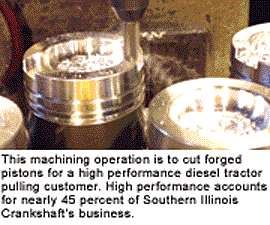
One of those markets is the company’s entry into performance work. Schaefer laughs when he explains how he first got into the performance market. "My first taste of high performance work came from a service manager at a local implement dealer who was also a tractor puller," recalls Schaefer. "The first time I went to talk to him about getting his dealership’s crank work, during the early days of our business, he almost threw me out. We joke about it now, but somehow we connected and I donated some of the block work on his first Super Stock motor. Jeannie thought I was crazy because she was the financial end of our business, but from there it has absolutely grown and continues to grow."
That first taste of high performance work was nearly 13 years ago. Today, high performance work accounts for nearly 45 percent of Southern Illinois Crankshaft’s business. All but a very tiny amount involves tractor pulling.
Schaefer says he doesn’t have any definite plans for seeking other high performance markets, but the purchase of a four-axis machine center makes additional involvement in the performance market, as well as other markets a possibility. Currently the machining center is used for manufacturing certain performance parts for the shop’s tractor pulling customers. Future plans would be to upgrade to a new five-axis machining center. However, if son Jeremy has anything to say about it, performance will continue to be a bigger part of the picture.
Although the Schaefers’ three daughters aren’t involved in the business, son Jeremy has been there since the beginning. Though he was just 8-years-old when his parents moved into the first shop, Jeremy says he remembers sweeping the floor and cleaning up before the equipment was moved in.
Jeremy attended college for a while, but decided he needed a break and went to work for his parents full time. Today, he is the shop manager, having worked his way up through all areas and on all the equipment in the shop. Even though he is working full time, he is attending night school to acquire an engineering degree. Jeremy recognizes the benefits of association involvement as well. "I like to be involved in AERA because everyone in it is a professional businessperson and I can really learn a lot."
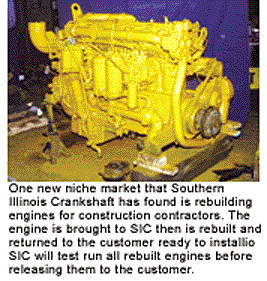
Learning from others and teaching his father are occupying the younger Schaefer’s attentions. "The sport compact and motorcycle markets have a lot going on right now and I think they offer a lot of opportunities." Although Mike says he was initially reluctant to look at those aspects of the business, his son has worked him over enough that he, too, now recognizes the opportunities.
The younger Schaefer has been a big asset to the high performance machining end of the business as well. Because he does the majority of the CAD/CAM work and the programming for the machining center, Jeremy was responsible for designing and programming the machining center to produce a new billet crankshaft for the tractor pulling market. And the prospects in this market look outstanding.
To keep his business growing, Schaefer continues to investigate new markets. Outside salesman Glenn Linnertz started in the shop, though he still spends some time in Red Bud, the goal is to have him on the road four to five days a week, traveling in a 150-mile radius.
It is this search for business that has helped Southern Illinois Crankshaft discover another niche market: construction companies in need of equipment repair or rebuilds. "We look for a company that is large enough to have many pieces of equipment, but not so large that it has a dedicated mechanic. The company may have a mechanic who is also an operator – in the summer he’ll be so busy that he can’t do a rebuild, so we can step in and take care of those issues for them."
In most cases, Southern Illinois Crankshaft’s customer will pull the engine and bring it to the shop, where it will be rebuilt and then returned. "We’ve found that contractors and owners run into the same thing we do as far as having enough people: the average contractor just doesn’t have the facilities or the manpower to open up an engine and get it rebuilt. That’s a void we see in our neighborhood."
Schaefer sees steady growth in the construction market. To meet the needs of one customer with several of a particular engine, Southern Illinois Crankshaft will likely buy a core, rebuild it and have it on the shelf to swap out as needed. A similar program for a few other customers is planned as well.
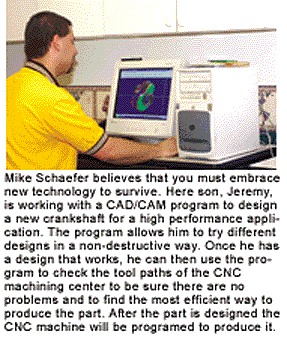
Because there have been so many changes in the industry, Schaefer says adaptability is critical. "When we started out, our main customers were construction and agricultural equipment salvage type customers, who used to drop work off literally by the truckload. I can remember seeing my finish grinder running 30-45 days behind with crankshafts piled up behind it – I haven’t seen that in six years. I think a lot of that is due to the availability of quality aftermarket crankshafts," he says. "The whole salvage industry seems to be upside down," Schaefer says. "At one point it was probably 90 percent of my business – in the next year or so it will probably be less than 10 percent. I’ve had to change my whole philosophy and my customer base – that’s put us behind the eight ball a bit. We’re starting to get a handle on it, but I should have gotten a handle on it a little bit sooner."
Mike says he is certain that his membership and involvement in AERA has kept him in business. An example of what Schaefer believes AERA offers to its members, but isn’t being utilized to its fullest are the conventions that are often overlooked as a source of new ideas and new business. "We picked up a new customer at the first convention we went to in St. Louis, and we still do business with them."
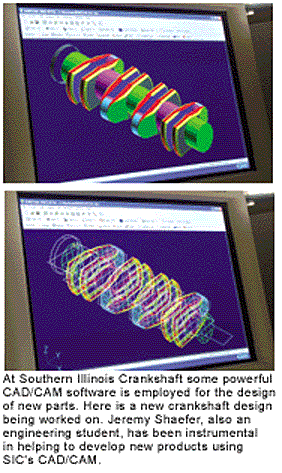
Schaefer believes that you have to go to the convention planning to do more than just look at equipment. "You have to ‘profit’ from the trip. When I go to a convention, there are several things I look for. I’m always looking at new equipment and new ways to do something, of course, but I’m also looking at the people I’m standing beside who I might be able to do business with, too. If I don’t make money when I come home from a convention, I didn’t do my job."
He continues: "Just like this AERA convention in Las Vegas, April 24-26 – sure, I’m going to be sworn in as chairman and the lights are going to shine on me and all that, which is fine, but when it’s all said and done, I have to profit from going to that convention."
Jeannie points out, "You can also pick up ideas when talking to another member who may be talking about how he got into a new market. Just by picking up that idea and bringing it back, I may be able to apply that principle to another aspect of our business and make it work for us, even if it isn’t a market we’re interested in."
One of Schaefer’s mottoes is "if you’re standing still, you’re going backward." He has several ideas that he would like to introduce as chairman, but one of them rings louder than the others: he would like to see all members take advantage of everything AERA has to offer, as he has. He wants to try to reach those members who are doing things the same way they have been for years. He believes that you can’t survive without change.
"Unfortunately, the shops that need the most help are the hardest to reach," he says. "They are guys who don’t even own a fax machine, much less a computer. They need to learn that you can’t operate in this industry the way that you did 50, 30 or even 5 years ago. I can’t operate my business the way I did a single year ago, there are just too many changes taking place."
Jeannie believes that AERA has a responsibility to educate its members because without members there is no organization. "Take a machinist who starts his own shop – he may be a great machinist, but he may not know what an income statement is and how his work affects that. AERA should be there to help him with that," she says. "AERA should teach him about the business of being in business. Just being a great machinist won’t keep you in business."
Several other things are on Schaefer’s agenda during his chairmanship. One is the continuation of the "process documentation" program. Mike feels that it is too important not to be finished and it needs to get out to the membership.
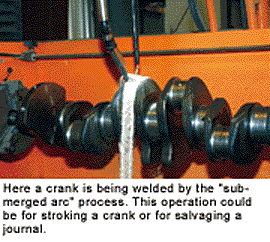
Process documentation involves putting down on paper the procedure for performing a certain process. For instance, Southern Illinois Crankshaft may have a particular step-by-step procedure for inspecting crankshafts. By documenting that procedure, any employee can step in and properly inspect a crankshaft if the regular "crankshaft inspector" is absent. It is particularly useful in smaller shops where everyone does several different jobs. Process documentation can be applied to virtually any procedure performed in your shop.
Process documentation provides a "playbook" for your shop, explains Schaefer. For instance, if you were to sell your business, the new owner could simply apply your process documentation program and not lose any quality or performance. AERA is trying to standardize the process documentation procedure, and make it available to all members.
Since leaning on AERA almost from the day he opened his doors, Mike Schaefer is pleased that he has now been able to repay some of the knowledge and help he has received from the association and says he will continue to give back as chairman in 2003.
Photos by the author













